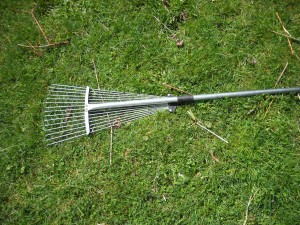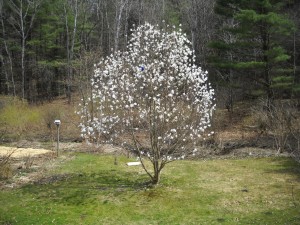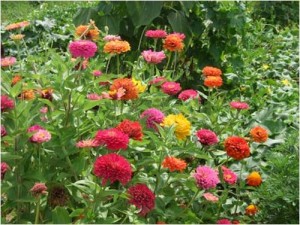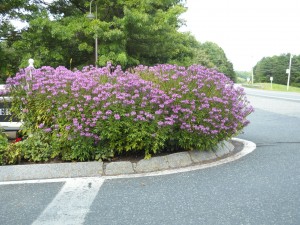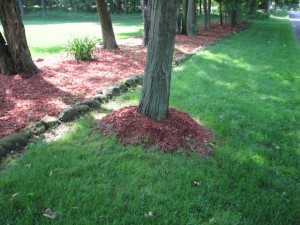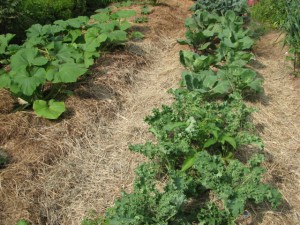Spring Tasks in the Garden
April has been a busy month for most gardeners because it has been warm and sunny. Our flower gardens and trees have woken up early, allowing us to do tasks we might, in other years, put off until May. Here are some jobs I‘ve been working on – and you should be, too.
Raking the lawn. Always one of my least favorite jobs, it needs to be done if you want a good looking lawn. But really, there are only 2 places where it’s critical: First, remove the piles of sand and gravel dumped along the edge of the driveway by the snowplow. Your lawn will suffer if they aren’t removed. Second, harvest the soil pushed up by moles in the lawn. I collect the soil from those piles and use it as fill dirt. The rest of the lawn? Any dead leaves will be chopped up by the lawnmower and disappear – and add some nice organic matter to your lawn’s soil.
Raking the flowerbeds. This I enjoy. I love seeing what plants have come safely through the winter, what is waking up and sending forth shoots. I rake carefully, so as not to break off the growing tips of peonies or other delicate flowers. I start with a rake to clean up around a clump of shoots, and then bend over to gently “rake” the clump itself with my fingers. I use an expanding lawn rake with a telescopic handle. I can adjust the width of the rake from about 7 inches to about 22 inches, allowing me to rake carefully in-between plants. I found the rake locally at my feed-n-grain store.
Pruning. I’m mostly done with this spring task, but I’m still tweaking apple and pear trees as I walk around the property with a holstered pruner on my hip. Recently I cleaned up lots of root suckers –shoots – coming up around the base of a crab apple tree. And I shaped up my roses, cutting back long, lanky stems to create nicely rounded plants.
I just finished pruning my grapes. They need to be cut back severely each year, as they would get too unruly if I didn’t. They produce grapes on new growth, which is stimulated by pruning. I have a 2-wire system on the south side of my barn and prune back to thicker, older canes and the 6-inch spurs that I allow to grow off them.
Planting. At this time of year my garden soil is usually cold and wet. Not so this year. I have planted seeds for carrots, beets, parsnips, scorzonera, salsify (all are root crops), parsley, spinach and greens. Peas could be planted now, though I have decided to skip them this year. I also have transplanted little lettuce plants and other interesting greens that I started indoors at the end of March, including chicory and mesclun. Some folks I know have already planted potatoes, but I wait until June.
I believe (but cannot prove) that planting potatoes in June helps to reduce problems with potato beetles. I like to say they’ve already gone to my neighbors’ potatoes, so avoid mine. But who knows? I watch for the beetles and pick any I find early on, so (hopefully) few produce a second generation.
That same technique works on slugs: control them early to prevent big outbreaks later on. I use an organic slug control product, Sluggo, which is iron phosphate covered with slug bait. Iron phosphate is a naturally occurring mineral that is said to be safe for pets and wildlife – and approved for organic gardeners.
Last fall I neglected to work on my blackberry patch, so I’ve been cleaning it up now, along with help from my intern, Gordon Moore. He cut out all last year’s fruiting canes (which die after bearing fruit). The patch has gotten to be 10 to 12 feet across, so we created a path down the middle of it by pulling out plants as needed. Then we pinned down a 2-foot wide strip of heavy landscape fabric (using landscape staples) and he covered it with a 2-inch layer of chipped branches I got from an arborist.
I weeded the patch and top dressed it with organic fertilizer and other minerals including green sand and Azomite. Green sand provides extra potassium and micronutrients from the sea. Azomite is a brand- named product that contains a wide array of finely ground rocks to provide micronutrients. After adding those minerals, we spread chipped branches around the plants, too.
To keep the blackberries from flopping over when laden with fruit, I have a 2-wire fence on the outside. The lower strand is 30 inches off the ground, the upper is 60 inches. Gordon and I tightened up the fence, which had gotten floppy. Along the center walkway I tied canes to 5-foot grade stakes as needed. It’s a huge improvement! (There’ll be no more need for blood transfusions after picking berries.)
Finally, I spend time right now admiring my flowers. My Merrill magnolia tree has been spectacular and fragrant. Shad bushes, a native plant (Amelanchier spp.), are in full bloom now- both the planted ones and those at the edge of the road and field. All my daffodils – early, mid-season and late – bloomed at the same time this year, so I am picking them and bringing inside to enjoy. I hope you will find time, too, to slow down and enjoy your flowers.
Henry Homeyer is a life-long organic gardener and the author of 4 gardening books. His Web site is www.Gardening-Guy.com
Starting Flowers by Seed: Now is a Good Time
Imagine this: you walk into your house and everywhere you turn there are vases full of gorgeous, colorful flowers. Light green zinnias on the kitchen counter, pink and white cosmos on the hall table, blue bachelor buttons in a crystal vase on the dining room table. In fact, imagine every flat surface in the house with a vase filled with flowers. You can do that. Start planting annual flower seeds now and it can be a reality sooner than you think – annuals are fast growing.
You don’t have to spend a fortune at the local garden center buying plants in June. Start annuals now and tend them for 6-8weeks indoors. Plant them in full sun once frost has departed for the summer and ground is warm. Water lightly, whisper a few kind words to them, and keep the weeds down. They will reward you handsomely.
Easy-to-start flowers include cosmos, zinnias, annual bachelor buttons, and marigolds, among others. You’ll need some lights to grow them well indoors until summer. I use 4-foot fluorescent shop lights that I hang just 6 inches over their tops. If you grow them without lights they tend to get long and leggy. I suppose you could carry them outside every day and bring them in at night, but the mornings here are still pretty cold. It should be 50 outside before you take them out.
Some annual flowers are best started outdoors. Sweet peas are lovely, usually fragrant flowers that can be started outside as early as regular eating peas – anywhere from mid-April forward. Before planting the seeds soak them for 24 hours to hasten germination: otherwise they can take up to a month to germinate, leading some people to give up on them. And if you wish to start some indoors, know that they need cool temperatures to germinate, so do not use a heat mat.
The usual method for planting peas is to work some compost into the soil and create a furrow 2 inches deep. Plant the seeds 3-4 inches apart and an inch deep. As they grow, you can then fill in the furrow around the plants. Most sweet peas will need a trellis or fence to attach themselves to. One way to do that is to use the branches pruned off your apple trees – just poke them into the soil and let the vines climb up. Chicken wire or bamboo stakes will also work.
Another cold-loving annual is larkspur, which is also called the annual delphinium. It needs cold soil to germinate and hates to be transplanted, so I recommend planting it directly in the soil – which you can do now. Sprinkle seeds on the soil surface and cover with a quarter-inch or less of fine soil. I often use an old sieve or colander to shake sifted soil over seeds needing a thin cover. Once seedlings are up you will need to thin out the plants. If you want masses of plants, thin to 6-9 inches, and they will stay relatively short. If you thin to 12-18 inches they will grow taller, particularly if you select tall cultivars. And plant seeds in a pattern so when they start to grow you will know they are not weeds!
If you have gotten discouraged with perennial lupines because they get loaded with aphids and the leaves turn brown and ugly by mid-summer, think about growing annual lupines. I never have, but am currently looking for seeds. The species that sounds best is Lupinus hartwegii. It comes in an array of colors including blue, pinks, white and gold. But it is not for everybody. It takes2-3 weeks to germinate, and the seeds need to be soaked in warm water (in a thermos) for 24 hours, or nicked with fingernail clippers. I am looking locally for seeds, but have also found the seeds on-line at http://www.swallowtailgardenseeds.com .
Once the soil warms up and frost is past, you can plant nasturtiums and sunflowers directly in the soil. But be advised that sunflowers don’t always point their faces where you want them to. They face the sun, which may be away from you. So I suggest putting them next to the barn or house. That way they will always be looking outward toward the light. They now come in an incredible variety of colors and heights, and may have several flowers on a single stem.
Most annuals don’t need rich soil or lots of nitrogen. In fact, cosmos, cleome and nasturtiums are notorious for growing tall (or long) with lots of leaves but no flowers until late in the summer if given fertilizer. On the other hand, some modern varieties of petunias and verbenas planted in containers really do need regular fertilizing to keep them pumping out the blossoms.
One last bit of advice: despite what you were told in kindergarten, pinching is good. Pinching almost any annual (or using scissors to snip off the top) when it is 3-4 inches tall will encourage it to be bushier, producing multiple stems. Cut just above a bud or leaf.
I admit that I still spend a fair bit on annuals at garden centers each spring. I can’t start every annual I want indoors – my time and space are limited, and I devote more to my tomatoes and other veggies than to flowers.
Henry Homeyer is a gardening consultant, designer and author. His Web site is www.Gardening-Guy.com. Reach him by e-mail at henry.homeyer@comcast.net.
To Mulch or Not to Mulch – and How?
For more than a month small trucks laden with chipped bark or wood chips have been scurrying around, unloading piles of mulch. Mulch (from the rich dark color of Mississippi mud to the orange hues of your grandmother’s pumpkin pie) has been spread over flower beds and piled high against the trunk of trees. It will hold down weeds and keep in moisture. But using mulch can have a downside, too. Let me explain.
It is important, if you are using a wood-based mulch, to put on a layer of an appropriate thickness. You shouldn’t just add a new layer of that pumpkin-colored mulch to last year’s mulch just because it’s dirty or the color has started to fade. You need to rake off the old mulch before applying a new layer. A gentle spring rain will not penetrate a 4-6 inch layer of mulch, and eventually the soil will dry out.
Next, there is the question of how mulch is applied near trees. Some landscapers favor the “volcano” look. While it is true that a 12-inch volcano of mulch will keep grass from growing up around your favorite crab apple tree, the mulch will eventually lead to bark rot, a compromised cambium layer, and a slow death. (Except for blueberries, which seem to thrive on mulch or sawdust piled right up to their stems).
Any wood-based, chipped mulch will eventually be host to fungi that break it down. Those same fungi will work on the bark of your tree and eventually break it down, too. Because it takes 6-12 years for a tree to decline and die from compromised bark, the cause and effect is not obvious. You can avoid the problem by leaving a donut hole around the tree – 6 inches of clear space between the trunk and the ring – the donut – of mulch.
Then there is the question of what is in your wood mulch? As a landscaper and garden designer I have occasionally needed to buy a few bags of wood mulch, even though I prefer to buy in bulk from a family-run business that makes its own. But when I do need to buy mulch, I read the label. If the mulch has been dyed with a chemical, I avoid it and go elsewhere to buy good mulch. Why? Because I am an organic gardener. It’s true that most gardeners only use wood-based mulch on flower gardens. Still, I don’t want chemicals introduced to my environment, or that of my clients.
Some years ago I visited radio personality Ray Magliozzi (of NPR’s Car Talk program) at his home in a Boston suburb. Ray was a late-comer to the organic movement. He became an organic gardener after his beloved collie died of cancer. He realized that the lawn jockeys he hired were spreading weed and fungus killers, along with their mowing and fertilizing. He questioned if there was a relationship between his dog’s illness and the chemicals. The same question could be asked about the chemical dye in mulch. What is it? How does it affect us?
So what are the alternatives to commercial wood-based mulch? My choice? Chopped leaves. Leaves run over by the lawnmower and saved last fall for use now. Trees mine minerals from the soil, and then shed their bounty to share with us each fall. Once wet, they don’t tend to blow away.
What about cocoa or buckwheat hulls? They are very tidy to look at and I’ve tried both, but they are very expensive to buy. Cocoa hulls, freshly applied, smell like chocolate chip cookies to me – and some dogs. I have heard that dogs can be sickened (or worse) by ingesting cocoa mulch (chocolate can be poisonous to dogs). That may be part urban myth, of course, but I tend to stay on the safe side. Cocoa hulls also tend to develop a slippery mold layer for a week or so, though it disappears eventually.
I use a layer of 4-6 sheets of newspaper covered with hay or straw in the walkways of my vegetable garden and around large plants, and it is effective at keeping down weeds. The inks are now soy-based and safe to use (in the old days the inks had heavy metals). I soak the papers overnight in a plastic bin first and drain the water in the driveway to get rid of any soluble chemicals in the papers.
Landscape fabric comes in many kinds. The good stuff is tough enough you can’t tear it with your hands; it allows rain to pass through, but little sunshine for hopeful weeds. My feed-n-grain store sells it by the foot, cutting it off a large wide roll, which is handy. It looks best with a thin layer of mulch on top. Black plastic is used by some in the vegetable garden, but it breaks down after a year and needs to go to the landfill. I avoid it.
Nature’s most persistent mulch is, of course, stone. I like small stones for walkways or occasionally in a flower bed. In either case, a layer of landscape fabric will do wonders for inhibiting weed growth.
So take a look around. If you see bark mulch being piled up on a tree trunk, make a citizen’s arrest. Or hand the culprit this article.
Henry Homeyer is a life-long organic gardener, gardening consultant, and UNH Master Gardener. His Web site is www.Gardening-guy.com.
Working On Apple Trees
Conventional wisdom has it that pruning apple and pear trees is best done before the flower and leaf buds open. This year many apples and pears are blossoming very early – even before we’ve had a chance to tune them up with an annual haircut.
I spoke recently with UNH Extension fruit tree expert Bill Lord about the effects of pruning after bud break. He explained that we can still prune, but that flower buds are a bit brittle once they start to open. So if you don’t want to lose fruit, be careful as you remove branches. But prune if needed.
Last weekend I worked on a young apple tree that I had planted about 5 years ago. It is shaping up nicely, but needed some work. The central leader, or the shoot that normally grows straight up to be the tallest of all branches, had bent over in the past year and 3 or 4 other branches were competing with it to establish themselves as the tallest.
That’s not good. I straightened the leader by tying it to a 10-foot piece of metal electrical conduit that I placed next to the trunk.
The apical tip (the tip of the tallest branch) of an apple tree produces plant hormones called auxins that control the growth and fruit production of the tree. If there is no clearly defined leader, many branches will reach upward and compete to become the leader, and the tree will not be as fruitful as possible.
A vigorous young tree with no leader often has many unneeded “water sprouts” shooting straight up from its branches. To reduce water sprout production a leader needs to be selected and the competitors either removed (not just cut back a little) or bent downward.
Bill Lord warned that cutting back (or heading off) branches that are competing with the leader results in lots of small branches starting up near the pruning cuts. That creates shade in the center of the tree, which is exactly what you don’t want. Pruning should create open spaces so all the leaves can get sunshine. So remove the entire competing branch or tie it down, don’t just cut off the tip.
You can easily change the angle of a branch when it is still young – say an inch in diameter or less. I did that for three branches on my young apple tree, though Bill Lord told me afterwards that branches are still stiff right now and that early May would be better. I tied a clove hitch around each branch with quarter-inch diameter nylon rope, and then anchored the branches to gallon jugs full of water or to good sized stones. Don’t use wire or narrow twine to tie down a branch – it could cut into the branch.
In order to get good fruit production it is also important to have the scaffold branches of a tree at the proper angle. Scaffold branches are the side branches that will ultimately produce fruit spurs (3-4 inch long branches with fruit buds). Scaffold branches rarely are at a right angle to the trunk, but should be angled up a little bit. Scaffold branches at an acute upward angle are not generally strong (so they may break in an ice storm) and usually do not produce much fruit. They need to be removed or bent to create a better angle.
Getting the soil from under your apple trees tested is a good spring activity. That way you can add minerals to the soil as needed. Bill Lord told me that trees that produce lots of apples often need potassium – he recommends a pound of potassium sulfate for every 5 bushels of fruit harvested, and noted that potassium sulfate is approved for organic gardeners (It’s a naturally occurring compound). He said you can also use Sul-Po-Mag, which is readily available and offers your soil sulfur, potassium and magnesium, if your soil test shows those minerals are needed.
Green sand is another good source of potassium for organic gardeners wishing to add potassium to their soil. Green sand is mined in New Jersey and sold at your feed and grain store or garden center. In addition to potassium, it is said to contain 30 trace minerals from the sea, where it originated. It is a good soil conditioner for heavy clay soils.
Bill Lord also suggests sprinkling a cup of old fashioned 20 Mule Team Borax around a full sized apple tree (or a couple of tablespoons around a young tree) every 3-4 years to add boron, a trace mineral, to the soil. It is needed for good cell wall growth and for fruit and seed development.
So go outside on the next nice day and look at your apple trees. Prune as needed, and try to be sure you have a good vigorous leader at the top of your tree. It will save you work in the future by reducing the number of water sprouts you need to prune out each year.
Henry Homeyer is a gardening consultant, pruner and educator. His Web site is www.Gardening-guy.com. You may e-mail him at henry.homeyer@comcast.net. He is the author of 4 gardening books.



